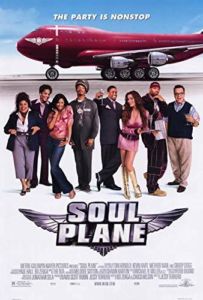Soul Plane: How Blacks Depict Themselves When They Think Whites aren’t Watching
Posted By Nicholas R. Jeelvy On In North American New Right | Comments DisabledHaving directed a couple of skits, ads, radio plays, artistic performances, and auteur hipster films in my time, I know that when people know they’re being filmed, they act strange. A lot of people think it’s the camera that does this to people, but in my experience it’s the knowledge of being perceived, scrutinized, and watched by “the public.” Put a camera in front of a woman’s face, and she starts imagining the reactions on social media. Take a full body shot of a man and he’ll suck in his belly and straighten his back.
This is true even outside of movieland. By observing, and announcing that we are observing, we modify the behavior of the observed. This is why voyeurism is so appealing: To observe without the observed knowing is to see them at their most natural.
In racial terms, white America rarely sees American blacks as they are. Whenever white America observes blacks, they put on a show. They are helpless victims [2], or maybe hard-ass niggas [3] from the ghetto ready to bust a cap in yonder honky’s ass. Maybe they’re swaggering macho men who wonder ‘fuck timmy gon’ do [4]” should they accost and proposition white women. But these are all performances, mostly put on for the benefit of the white observer. Even historically, the negro has performed for the white man. He has been a jive turkey, an Uncle Tom, a subservient lackey, a magical negro — all negro behaviors carried on for the benefit of the white man. It is rare that a white man is accorded a view into the heart of blackness without the blacks putting on a performance for him. Fortunately for us, such a view exists in the media that blacks produce for other blacks.
Which brings me to one of my favorite films, the 2004 by-blacks-for-blacks Soul Plane. Since seeing this film, I’ve continually asked myself about why I find it so good, aside from its pure comedic effect (which is astounding; it is a rib-cracking rollercoaster of laughter). The answer is that it allows us a peek into black Americans as they present themselves to themselves. The racial strife and pathologization of racial discourse characteristic of our age have made actual study of blacks in their own media taboo, but I find them a fascinating people to observe — if not to be neighbors with.
The movie opens with Nashawn Wayne, played by Kevin Hart, dreaming of air travel as a small child, and then running to catch a plane as an adult, his dog in tow. He has to check his dog in as luggage before he’s allowed on the plane. Once aboard, every other passenger is white. He’s loud and obnoxious to the stewardess and to the middle-aged white woman passenger sitting next to him. After a disagreement with a beef stroganoff, he runs to the bathroom, but his ass gets stuck in the toilet bowl during turbulence. Panicked, the stewardess tries to empty the airplane’s waste tank in order to release Nashawn, but she accidentally unloads the luggage, which results in his dog getting sucked into the plane’s engine.
 [5]
[5]You can buy James O’Meara’s The Homo and the Negro here [6].
As Nashawn is wheeled out of the airplane and into a waiting ambulance with a block of ice on his ass, he swears revenge on the airline company, loudly proclaiming that they’ll pay even if he has to go on every talk show in America. And indeed, a court presided over by an Asian judge with a majority black jury finds for him and awards him $100 million in damages. This leads Nashawn to start his own airline.
Pretty soon, NWA — Nashawn Wayne Airlines — is in business and ready for its maiden flight (O-69). We see it through the eyes of the Hunkees, a family of whites returning from their vacation to Crackerland. They turn a corner and end up in Terminal (Malcolm) X, and it might as well be Platform 9 3/4 by how alien it is. It’s the world of the American negro, transplanted into the logic of an airplane terminal. In fact, the entire movie follows this logic. An airline, an airplane, air travel — but black. They might as well have called it Spooks on a Plane or Nig-Nogs in the Sky. It’s like one of those Mel Brooks genre parodies, except the comedic element comes from the introduction of blacks and the notion that they can fly. Everything from pilot Mack, who is just Snoop Dogg playing himself, to co-pilot Leslie Gaeman (pronounced gay man), an African immigrant and notably more competent and professional than the other blacks, is just blackity-black and black, y’all. Mind you, since the movie was made in 2004, it depicts the black aesthetic in a manner which is not completely fake and commercialized out of existence, so it falls just within my tolerance window for vulgarity.
We’re treated to an ensemble cast of blacks, Sofia Vergara (¡Ay, caramba!), and of course the Hunkee family, consisting of inoffensive and ineffectual patriarch Mr. Hunkee, hypersexed Heather and Barbara, and dorky but negrolatric Billy. This is because, regardless of what Tariq Nasheed tells you [7], blacks are scared of white males and especially white male sexuality expressing itself. In Mr. Hunkee, white men are represented as blacks would have us be: bland, inoffensive, impressed by blackness, sexually incontinent around black women, and willing to be cuckolded by black men.
As Soul Plane is a movie by blacks for blacks, black dysfunction — or what the white eye would consider black dysfunction — is on full display. Pilot Snoop Dogg is completely unqualified and overdosing on mushrooms. Nashawn’s deadbeat cousin is running gambling and stripper operations onboard, and hiring the unqualified Snoop Dogg. There are two overweight, ugly shaniquas abusing their power as security officers to grope attractive men and give them cavity searches. Everything that blacks really are is on display, and more, for our comedic enjoyment. We are given a glimpse into their world as they perform without knowing they are being observed by white people. This is what the first European explorers in Africa must have felt like.
Soul Plane comes from the relatively simpler time of the early 2000s, when it was still possible for blacks to have their own media spaces where they wouldn’t expect the white gaze to penetrate. Lords of the Bling [8] and Don’t Be a Menace to South Central While Drinking Your Juice in the Hood are also from this period. Unfortunately, once American blacks took their position as the nominal heads of the bioleninist coalition, they allowed themselves to become the cudgel in the hands of the woke Left in order to bludgeon white people. Subsequently, they lost the privilege of having their own conceptual and media space where the white gaze is presumed not to exist. Today, everything blacks do is watched, so they are always performing for whites, and increasingly, they’re allowed no role apart from that of the victim. People have speculated that the decrease of quality in rap music and other black media is due to the emasculation felt by black men as they’re forced into the role of perpetual victim. But they can’t walk away from this deal, because the benefits of it are too staggering. (Crime is basically legal for them now, after all.)
Were they not instrumentalized against white people in America, I suspect we’d be able to appreciate black art and comedy. Whatever else can be said about them, they are a creative people, and while their culture might be a little lowbrow by white standards, they’re at least entertaining. If steps could be taken towards a racial divorce in America and elsewhere, we could perhaps resume the cultural dialogue between white and black. Until then, gems of black ingenuity like Soul Plane will remain mementos of a rapidly disappearing time.
* * *
Counter-Currents has extended special privileges to those who donate $120 or more per year.
- First, donor comments will appear immediately instead of waiting in a moderation queue. (People who abuse this privilege will lose it.)
- Second, donors will have immediate access to all Counter-Currents posts. Non-donors will find that one post a day, five posts a week will be behind a “paywall” and will be available to the general public after 30 days.
To get full access to all content behind the paywall, sign up here:
Paywall Gift Subscriptions
 [9]If you are already behind the paywall and want to share the benefits, Counter-Currents also offers paywall gift subscriptions. We need just five things from you:
[9]If you are already behind the paywall and want to share the benefits, Counter-Currents also offers paywall gift subscriptions. We need just five things from you:
- your payment
- the recipient’s name
- the recipient’s email address
- your name
- your email address
To register, just fill out this form and we will walk you through the payment and registration process. There are a number of different payment options.
